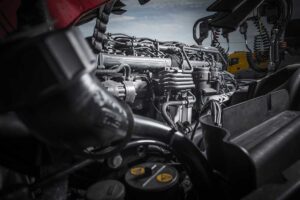Getting selected for a DOT (Department of Transportation) inspection is a lot like going to the dentist. Nobody looks forward to the occurrence. The best you can hope for is that nothing bad (or expensive) is discovered.
There’s another similarity to that dentist visit, too. All too often, the painful results could have been prevented by the owner, if sensible precautions had been taken.
The reality of a DOT inspection is that nothing is inspected that shouldn’t be regularly inspected by the driver.
All too often, however, drivers receive citations for simple violations like air leaks, chafed hoses or inadequate tire tread. These items are easy to find and fix but often go unnoticed until pointed out by an inspector.
Thanks to the PSP (Pre-Employment Screening Program) administered by the Federal Motor Carrier Safety Administration (FMCSA), violations noted during an inspection can be recorded on the driver’s PSP report. This report is ordered by prospective employers when considering a driver’s application. Each carrier uses the data in different ways, but if there’s a pattern that shows the driver doesn’t routinely inspect equipment, it could impact the company’s decision to hire the driver.
Then, there’s the CSA (Compliance, Safety, Accountability) program. If you own your own trucking business, your CSA score can impact your ability to lease with other carriers or do business with customers or brokers.
Still, the biggest impact of a DOT inspection may be the time lost to the inspection itself and making repairs, especially if those repairs are to correct an out-of-service (OOS) violation.
Waiting for a service truck to arrive and replace a tire, for example, means absorbing the cost of the service call AND the potential revenue lost if your load can’t be delivered on time. Losing a day to wait for another appointment can cost more than the service call.
The DOT lists eight levels of inspection, but most drivers need only be concerned with the first three.
A Level III inspection, the most common type, examines a driver’s credentials. It seems obvious that a driver should have a valid CDL for the vehicle driven, along with medical certification card when required, but drivers are often cited for missing these. Level III inspections usually include a review of the record of duty status and verify that the carrier is properly identified. Inspectors often observe seatbelt use as well.
A Level II inspection includes those items in Level III plus a walk-around check of the equipment for obvious violations. Inspectors may look at lights, listen for air leaks and check for poor cargo securement, missing lug nuts and other items that are easy to identify.
Level I is a full-blown inspection, where brakes, steering and other components are checked for wear and damage — along with everything included in Levels II and III.
The first step in passing a DOT inspection is to not get inspected.
While inspectors sometimes choose trucks to inspect at random, they often choose based on their observation of trucks in the area. Trucks with obvious issues, such as a burned-out headlight, are prime targets. Trucks that have papers and trash all over the dash and visible through the windshield are practically volunteering for inspection. Sometimes, inspections are the aftermath of a traffic violation for which the driver may or may not receive a citation.
The best defense against a bad DOT inspection, however, is to regularly inspect both tractor and trailer and make repairs as necessary.
Much of this can be accomplished during a daily pre-trip inspection. Tire tread wear doesn’t happen overnight, but tread or sidewall damage could easily have occurred since the last inspection. Lights go out, wire connections corrode, air line connections weather and leak, hose retainers slip or break — any number of items can change between inspections.
Air leaks can be especially troublesome and difficult to catch if they aren’t loud enough to hear.
Service line leaks at the rear of the trailer, for example, won’t show up during a walk-around inspection, because the service brakes aren’t being used. Unless the leak is loud enough to hear from the cab, it can remain undetected.
However, in cab brake-checks can help you detect a problem. Holding down the brake pedal while watching the gauge for any pressure loss can tell you if the system is leaking. It’s one of the checks a DOT inspector will perform, so you’ll come out ahead if you do it first.
Another in-cab air check involves pumping the brakes to release air pressure and then watching to see when the warning light/buzzer activates and at what pressure the tractor protection valve engages (pops out). If those things aren’t happening, there’s an issue that should be fixed as soon as possible.
It’s not uncommon for brake violations to be discovered during a DOT inspection.
Pushrod travel is measured, and if two or more are found to be out of adjustment, the vehicle is placed OOS.
Brake drums and rotors are inspected for damage, and pads and shoes checked for wear, damage or contamination. For drivers who never get under the truck, these checks can be a problem.
Most modern commercial vehicles are equipped with automatic slack adjusters, but these can still get out of adjustment. When they do, manufacturers recommend they be replaced rather than manually adjusted. The important thing is to have them inspected regularly so problems can be identified before a violation is discovered in a DOT inspection.
Any machinery that undergoes the stressful conditions faced by commercial motor vehicles should be expected to require periodic maintenance.
Today’s trucks are built to run for many thousands of miles before parts wear out and need replacement, but things can and do go wrong. Regularly inspecting your vehicle and repairing or replacing problem parts is the best way to minimize the likelihood of getting shut down during a DOT inspection.
Cliff Abbott is an experienced commercial vehicle driver and owner-operator who still holds a CDL in his home state of Alabama. In nearly 40 years in trucking, he’s been an instructor and trainer and has managed safety and recruiting operations for several carriers. Having never lost his love of the road, Cliff has written a book and hundreds of songs and has been writing for The Trucker for more than a decade.









